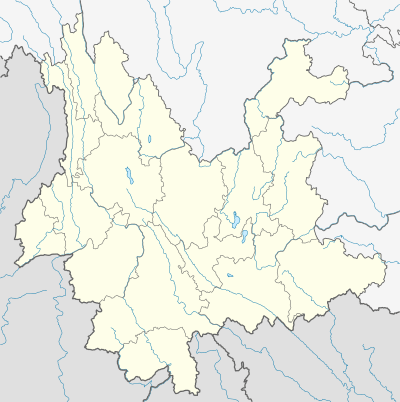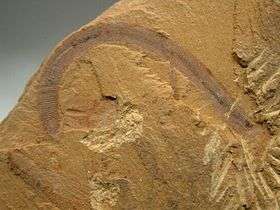Chengjiang
Chengjiang (Chinese: 澂江; often spelled Chinese: 澄江; pinyin: Chéngjiāng; earlier Tchinkiang) is in Yuxi, Yunnan Province, China, just north of Fuxian Lake.
Chengjiang 澂江市 | |
|---|---|
.png) Location of the county (red) in Yuxi (yellow) and Yunnan (light grey) | |
 Chengjiang Location of the county seat in Yunnan | |
| Coordinates: 24°39′02″N 102°56′06″E | |
| Country | People's Republic of China |
| Province | Yunnan |
| Prefecture-level city | Yuxi |
| Area | |
| • Total | 804 km2 (310 sq mi) |
| Population | |
| • Total | 146,293 |
| • Density | 180/km2 (470/sq mi) |
| Time zone | UTC+8 (China Standard) |
| Postal code | 652500 |
| Area code(s) | 0877 |
| Website | www |
| Official name | Chengjiang Fossil Site |
| Criteria | Natural: (viii) |
| Reference | 1388 |
| Inscription | 2012 (36th session) |
| Area | 512 ha (1,270 acres) |
| Buffer zone | 220 ha (540 acres) |

Chengjiang Fossil Site
In evolutionary biology, and especially paleontology, Chengjiang is noted for soft-tissue fossil finds, of the Maotianshan Shales, dated less than 518 million years ago during the Cambrian explosion, which "are as spectacular as the Burgess Shale fauna, and significantly older."[1] These fossils are considered one of the most important fossil finds of the 20th century. They contain an exquisite degree of detail, cover a diverse range of fauna, and are significant in attempts to understand the evolution of life on Earth.[2][3]
The fossils were first discovered by Henri Mansuy and Jaques Deprat who described them in 1912, the year after Charles Walcott's initial publications on the Burgess Shale. It was not until 1984 that the true significance of the palaeontology of the region was realised by Hou Xian-guang, a professor at Yunnan University, Kunming, where he is director of the Research Center for Chengjiang Biota. Previously he was a professor at the Palaeontological Institute, Chinese Academy of Sciences, Nanjing.
Chengjiang is an underdeveloped city having rich phosphate deposits above and below the formation holding the lagerstätte. They have been exploited in part through efforts that began at about the same time that Hou Xian-guang discovered the deposits that bear these exceptional fossils, with phosphate mining bringing in some 2/3 of the city's revenue in 2003. Efforts were made to close the region to mining in a bid to support the city's bid for listing as a World Heritage Site, given the scientific significance of the fossils. A consequence of this was renewed mining efforts in the region, which threatened the fossil-bearing strata due to erosion, slumping of overburden, and simple destruction by the mining efforts.
Chengjiang faces a dilemma between calls for preservation of the treasure trove of early Cambrian fossils, the economic reliance it has on the phosphate industry, and the difficulty of finding a balance between exploitation and restoration of the land while this is still possible.[3]
Climate
| Climate data for Chengjiang (1981−2010) | |||||||||||||
|---|---|---|---|---|---|---|---|---|---|---|---|---|---|
| Month | Jan | Feb | Mar | Apr | May | Jun | Jul | Aug | Sep | Oct | Nov | Dec | Year |
| Record high °C (°F) | 24.1 (75.4) |
27.2 (81.0) |
29.1 (84.4) |
31.5 (88.7) |
32.9 (91.2) |
30.7 (87.3) |
31.4 (88.5) |
29.7 (85.5) |
30.7 (87.3) |
27.7 (81.9) |
26.0 (78.8) |
24.0 (75.2) |
32.9 (91.2) |
| Average high °C (°F) | 16.5 (61.7) |
18.6 (65.5) |
22.0 (71.6) |
24.9 (76.8) |
25.0 (77.0) |
25.1 (77.2) |
25.1 (77.2) |
25.4 (77.7) |
23.8 (74.8) |
21.4 (70.5) |
18.6 (65.5) |
16.0 (60.8) |
21.9 (71.4) |
| Daily mean °C (°F) | 9.4 (48.9) |
11.2 (52.2) |
14.4 (57.9) |
17.8 (64.0) |
19.7 (67.5) |
20.8 (69.4) |
20.8 (69.4) |
20.6 (69.1) |
19.0 (66.2) |
16.6 (61.9) |
12.8 (55.0) |
9.5 (49.1) |
16.1 (60.9) |
| Average low °C (°F) | 4.4 (39.9) |
5.7 (42.3) |
8.6 (47.5) |
12.1 (53.8) |
15.4 (59.7) |
17.6 (63.7) |
17.8 (64.0) |
17.3 (63.1) |
15.9 (60.6) |
13.6 (56.5) |
8.9 (48.0) |
5.2 (41.4) |
11.9 (53.4) |
| Record low °C (°F) | −2.0 (28.4) |
−0.1 (31.8) |
−4.0 (24.8) |
3.2 (37.8) |
6.7 (44.1) |
10.9 (51.6) |
12.7 (54.9) |
11.7 (53.1) |
7.4 (45.3) |
5.4 (41.7) |
−1.9 (28.6) |
−4.4 (24.1) |
−4.4 (24.1) |
| Average precipitation mm (inches) | 13.8 (0.54) |
14.2 (0.56) |
16.8 (0.66) |
27.5 (1.08) |
79.7 (3.14) |
152.0 (5.98) |
210.0 (8.27) |
161.8 (6.37) |
111.6 (4.39) |
80.0 (3.15) |
42.3 (1.67) |
15.4 (0.61) |
925.1 (36.42) |
| Average relative humidity (%) | 71 | 65 | 60 | 60 | 69 | 79 | 82 | 81 | 78 | 79 | 77 | 75 | 73 |
| Source: China Meteorological Data Service Center | |||||||||||||
Further reading
- Guang, Hou Xian; Aldridge, Richard J.; Bergstrom, Jan; Siveter, David J.; Siveter, Derek J.; Xian-Hong, Feng (2004). The Cambrian Fossils of Chengjiang, China: The Flowering of Early Animal Life. Oxford, U.K.: Blackwell Publishing. ISBN 1-4051-0673-5.
- Donovan, S.K. (2006). "Book Review - The Cambrian Fossils of Chengjiang, China" (PDF). In PalArch's Journal of Vertebrate Paleontology. Retrieved 2009-10-15.
- Conway, Morris S. (1998). The Crucible of Creation. Oxford, U.K.: Oxford University Press. ISBN 978-0192862020.
References
- Sterelny, Kim (2007). Dawkins Vs Gould: Survival of the Fittest. Cambridge, U.K.: Icon Books. p. 116. ISBN 978-1-84046-780-2. Also ISBN 978-1-84046-780-2
- Dawkins, Richard (2004). The Ancestor's Tale: A Pilgrimage To the Dawn of Life. London: Weidenfeld & Nicolson. p. 77. ISBN 0-297-82503-8.
- "Chengjiang Maotianshan Shales Fossils". Fossil Mall: Science Section (fossilmall.com). Retrieved 2009-10-15.
